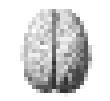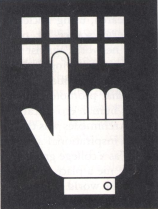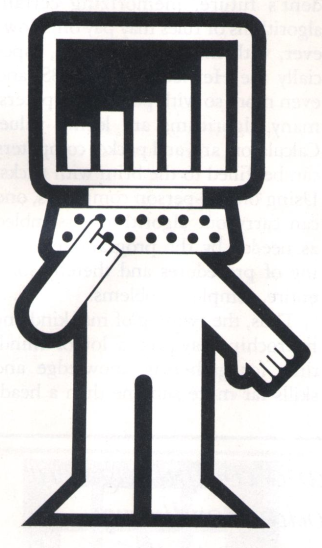Contents
Augmenting brains
Why Fleabyte?
Fleabyte fundamentals
Orality, Literacy, Computency
Unfinished Revolution
From elsewhere
Fleabyte fundamentals:
What you've got underneath may not take you to the top
A Flea in the Bonnet

Fleabyte Fundamentals: Originally published in the Journal of College Science Teaching 19 No. 2. November 1989. At the time this article was written, parents and educators were concerned that allowing students the use of calculators in school would rob them of such fundamental skills as doing arithmetic the then prevalent way. Henry K van Eyken 0 Fleabyte is my term of endearment for the pocket computer or, for that matter, any programmable computer that a person can carry as comfortably as a watch, ballpoint pen, wallet, or handkerchief. Like all these small and useful articles, Fleabyte is there when and where you need it. If any computer deserves to be called "personal," the honor must be little Fleabyte's. 1 Forget minor inconveniences such as small keys and screen size. Focus on presence instead. Continuous intimacy makes Fleabyte profoundly different from a laptop computer. Consider that other miniature, the watch. It has revolutionized our very lives. And so can Fleabyte. It can affect how we learn, it can affect what we learn, it can affect where we learn. It can augment our mental capacity—and so doing it can affect our way of thinking. 2 Let me account for this by getting down to fundamentals, the kind of fundamentsls that parents and educators worry about, the kind we wish to inculcate in our young. 3 * * *
Remember Pebbles? The tiny tot of Flintstone fame? Well, cartoon-time passes quickly and she is now a charming young lady—Wilma's spitting image, really—at a final examination in college math. Strewn about her are stone chips, probably from the quarry where her father, Fred, still labors. The examinaers are professors Rock and Hardplace. And this is what we hear: 4 Prof. Rock: Pebbles, tell us, how much is three times four? 4-1 Pebbles (barely giving the question a moment's thought): Twelve. 4-2 Prof. Hardplace: I'm sorry, Pebbles, that won't do. We have no alternative but to give you a failing grade. 4-3 Pebbles is shocked. She had worked very hard for this exam, and she feels her performance was superb. 4-4 Prof. Rock: Pebbles you have come to this examination with an unauthorized device. You used a memorized multiplication tablet. We, however, must insist on the application of fundamentals. 4-5 Prof. Hardplace: To pass this test, you should have made three collections of four chips each and then have counted all the chips. 4-6 Prof. Rock (kindly): Only then would we have visible evidence that you understand the problem. Only then could we have given you the credit for college math. 4-7 * * *
Knowing, understanding, professors—troublesome words, bothersome people ... No wonder college education is giving Pebbles a rough time. She knows how to multiply numbers and, yet, that knowledge does not demonstrate understanding. 5 Let's say that understanding begins with knowing fundamentals. For example, counting is more fundamental than mental multiplication. Therefore, Professor Hardplace's counting method of multiplying is closer to understanding than merely recalling an entry from a memorized multiplication table. 6 But is counting fundamental? It has been found that a goldfinch is usually able to distinguish three seeds from two, four seeds from three, but not four seeds from five. Goldfinches, and other animals as well, have a limited sense of numbers. And with evolution as a guide and experience as my strongest backing, I would guess that without consciously counting or arranging seeds in neat patterns, people only do as well as goldfinches. So, which then is more fundamental, counting or number sense? Furthermore, can we really recognize understanding? I rather doubt it. 7 Teachers can test for all sorts of knowledge, from knowledge of facts right up to sounndness of judgment.* But I, for one, cannot test for understanding unless, perhaps, I am able to identify that knowledge of fundamentals is inherent to correctly answering a question. And if I cannot define what the fundamentals are, then what? Can I find some primitive level at which to assess the quality of a student's knowledge? 8 Professors Rock and Hardplace had an answer. They felt that settling for the level of counting would be just fine. Little did they realize that millions of Pebbles' distant offspring actually learned to pass exams by merely recalling entries in memorized multiplication tables. Currently, handheld electronic calculators are replacing memorized tables, much mental arithmetic, and longhanded calculations. A black-box approach to thought replaces some fallible neural process by an efficient, electronic pas de deaux performed at our fingers' bbidding. 9 We learned longhand multiplication by memorizing a sequence of well-defined steps. Any such sequence is called an algorithm. An algorithm is a trick to solve a particular kind of problem in some especially expeditious manner. Algorithms save mental energy, algorithms save time. Algorithms—all black boxes—require mostly using one's memory. Depending on a student's future, memorizing certain algorithms or rules may pay off. However, with modern calculators, especially the Hewlett-Packard 28S,* and even more so with pocket computers, many algorithms are losing value. Calculators are, and pocket computers can be, filled to the brim with tricks. Using on-the-person computers, one can carry out algorithms by the programmed linking of procedures and thereby solve entire, complex problems. 10 Thus the twinning of mankind and microchip may free a lot of mindtime for gathering knowledge and skills far more sublime than a headfull of formulas. Future students, enjoying a more liberal education, may familiarize themselves with broad categories of knowledge and their relevancies. They may learn to explore, with and without computers, such categories for potentially interesting details and then solve problems with those details they judge applicable. Thus many topics revered today as fundamental—or merely important—may, chiefly at middle and higher levels of education, rust away. 11 * * *
The histories of writing and computing bear many similarities. 13 When I walk into a room full of computers, my mind's eye looks back to some scriptorium in the dark ages with its costly manuscript tomes chained to desks. Then I can't help but perceive that today's ordinary paperback will find its counterpart in the common pocket computer, even though there is still much resistance to acquiring personal computency. But, then again, did it not take thousands of years after the invention of the written language for literacy to become a common cultural necessity? 14 Especially important is the parallel to be found in literacy's effect on human consciousness. In a delightful little paperback, Walter Ong shows how becoming a literate society has caused formidable change in human consciousness.* This insight makes us consider how computing will further affect thinking. An old truism states that knowledge is power. Therefore, we need to consider the social implications of computency as well as its educational implications. One should not be surprised if computency, unless it becomes as democratic as literacy, will exacerbate social disparities. 15 Even without Ong's exposition, it is obvious that continuous intimacy with Fleabyte cannot but change our frames of mind. Consider how that watch keeps on chopping our lives into fractions of time. It furnishes only the time of day. How much more information shall we gather from Fleabyte! Adjusting to such a life is bound to be unsettling at first, but, it is my dream, that it will permit us to become more efficient thinkers and, hence, feel more comfortable in an intricate world. 16 The advent of continuous intimacy between humanity and Fleabyte will give a new connotation to much of what we call "using our heads." Precisely what "I understand" will come to mean I cannot now sense, but I suspect that the mind, when engaged in learning or work, shall be less occupied by rote routines and more frequently function at higher levels of the cognitive domain: the levels of analysis, synthesis, and judgment.* Education will concentrate on developing these qualities and likely do so by engaging students more often in complex problem solving. 17 Typically, students fear tasks that require a heuristic approach. But we simply can't continue to teach and test students in the rote application of memorized routines that not only may be useless soon, but also hinder them from gaining fresh insights. We can't keep training them for examinations by letting them repeatedly work the same types of problems, thus acquiring excessive, content-bound rote logic rather than being stimulated to use higher levels of thinking. We can't go on unflinchingly, at great expense to the community, in helping students develop skills that calculators and pocket computers have had on tap for years. 18 With the future becoming ever less predictable, we can't go on merely every now and then adding some learning and offsetting that learning by dropping something else. If we continue along this road, we may well deny the incoming generation an essential advantage in a threatening and threatened world; only elsewhere wil students learn to let electronics solve many of their routine problems while they put time to better use by tackling real problems and gaining heuristic experiences. 19 Acknowledgement 20 For thoughtful comments, I thank my Dawson colleagues, Drs. Gerald Brydon (chemistry), John Denton (mathematics), David Fielding (philosophy), and Peter Sinclair (sociology). 20-1 Author 21 Henry K van Eyken teaches in the Department of Chemistry and Chemical Technology, Dawso College, 3040 Sherbrooke St. W., Westmount, Quebec, Canada H3Z 1A4. In addition to teaching college chemistry the author conducts a course, "Pocket Computers in Education," under the auspices of the University of Sherbrooke. 21-1
References fn 1. Hedges, William D Testing and Evaluation for the Sciences in the Secondary School. Wadsworth Publishing Company, Inc. 1966. * fn1 2. Ong, Walter J., S.J. Orality and Literacy. Methuen. 1982. * fn2 |
--
| top of page |
|

